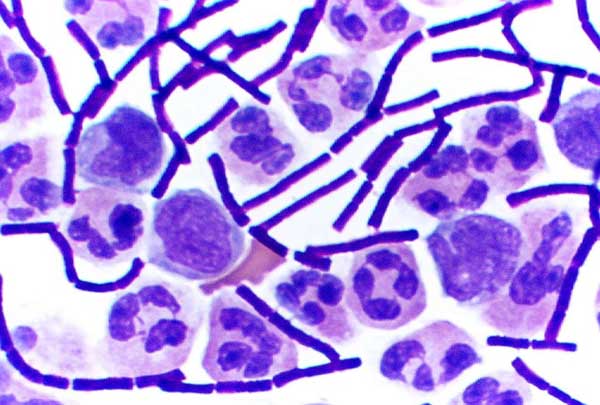This is an old revision of the document!
Table of Contents
Biological Weapons
Types of Biological Weapons
There are many possible ways of exposure of exposure to biological agents, including bombs and grenades containing the agent, aerosol sprays, brushes for contaminating surfaces, by injection, and by food contamination (CDC, 2015). According to Johns Hopkins Centre for Public Health Awareness (n.d), there are three classes of potential biological weapons: A, B, and C. The classifications are ranked in order of severity of the potential health impact based on the type of agent, mode of delivery, lethality, and potential to cause disruption.
Class A- Anthrax
Class A biological weapons are given the highest priority. This is because they have the highest potential for dissemination and can cause the highest mortality rates in comparison to class B or C. Additionally, they require the greatest amount of public health preparation. A popular example of a class A biological weapon is Anthrax, however there are many others listed such as; botulism, plague, tularemia, small pox and viral hemorrhagic fevers (CDC, 2015).
Anthrax is a serious infectious disease caused by Bacillus anthracis bacteria. The bacteria is rod-like, as shown in Figure 1, and forms bacterial spores, commonly affecting wild animals through contaminated soil and water. Humans contract the disease through consumption of contaminated animal products. Anthrax is rare but is more common in countries that do not have public health programs that routinely vaccinate animals against anthrax (CDC, 2015). 
After WWII, 103 countries signed a treaty designed to eliminate the use of anthrax as a weapon. However, some countries and terrorist groups still develop B anthracis as an agent of mass destruction (CDC, 2015). The true extent of the threat of anthrax is difficult to evaluate. The production of the agent is extremely difficult due to the size and number of spores required to cause an outbreak, and many previous attempts have been unsuccessful. (Tasota, Henker, and Hoffman, 2002).
Pathogenesis
When inside a host organism, the bacterial spores can reside in macrophages and takeover the lymph nodes. The mature bacteria then prevent phagocytosis and freely move around the lymphatic system. The spores can also release edema toxin, affecting water balance and causing swelling. Furthermore, lethal toxin release can stimulate tumour growth factors and cause massive hemorrhage. Thus, these toxins can rapidly cause respiratory distress, sepsis, and meningitis (Tasota, Henker, and Hoffman, 2002).
Class B- Food Safety Threats: Salmonella
Class B contain biological weapons that still pose a threat but to a lesser extent than class A. They will result in lower amounts of mortality and require less public preparation. An example of a Class B agent is Salmonella or any other food safety threat (CDC, 2015).
Salmonella is one of many types of food-borne illness. Common symptoms of salmonella are nausea, vomiting, and diarrhea. Symptoms can sometimes be severe and even be life-threatening, especially if an individual is vulnerable to infection, such as pregnant women and children (CDC, 2018).
Pathogenesis
Salmonella enters the body through food ingestion. However, there are certain requirements for salmonellae to be fully pathogenic. It must have the ability to invade cells, replicate intracellularly, release toxins, and a complete lipopolysaccharide coat. This is a coat that is comprised of fats and carbohydrates and it helps induce an immune response in animals (Raetz & Whitfield, 2002). After passing the gastric acid barrier, it invades the mucus membrane of the small and large intestines and produces toxins. The mechanisms that explain how the epithelial cells are invaded are not fully understood. However, invasion does require an initial binding to specific cell receptors on surface of the intestinal epithelial cells. The initiation of invasion is marked by the pathogen irritating or ‘ruffling’ the intestinal lining cells. That ends up causing pinocytosis of the pathogen. Pinocytosis is also referred to as ‘cell drinking’ where small particles are brought into the cell (Holter, 1959).
After invasion, the epithelial cells release proinflammatory cytokines (Gianella, 1996). Cytokines simply regulate host responses to invasions, infections, immune responses and trauma. Proinflammatory cytokines promote inflammation and can often aid in disease progression. In the case of salmonella, this inflammatory response causes diarrhea and can even lead to ulceration and destruction of the mucus membrane. The salmonella bacteria can also leave the intestines and go on to affect many other organs and tissues (Dinarello, 2002).
References
Tasota, F. J., Henker, R. A., & Hoffman, L. A. (2002). Anthrax as a biological weapon: an old disease that poses a new threat. Critical care nurse, 22(5), 21-34.
CDC. (2015). Anthrax. Retrieved from https://www.cdc.gov/anthrax/basics/index.html
CDC. (2018). Food Borne Illness and Germs. Retrieved from https://www.cdc.gov/foodsafety/foodborne-germs.html
Dinarello, C. A. (2000). Proinflammatory cytokines. Chest, 118(2), 503-508.
Giannella, R. A. (1996). Chapter 21: Salmonella. Medical microbiology, 4.
Holter, H. (1959). Pinocytosis. In International review of cytology (Vol. 8, pp. 481-504). Academic Press.
Raetz, C. R., & Whitfield, C. (2002). Lipopolysaccharide endotoxins. Annual review of biochemistry, 71(1), 635-700.